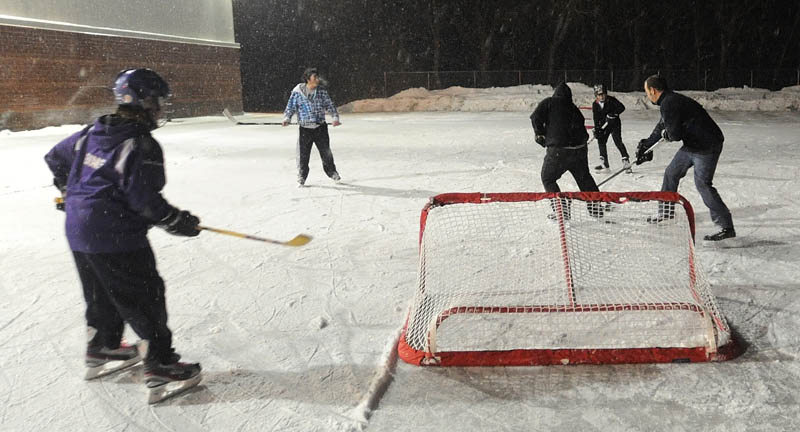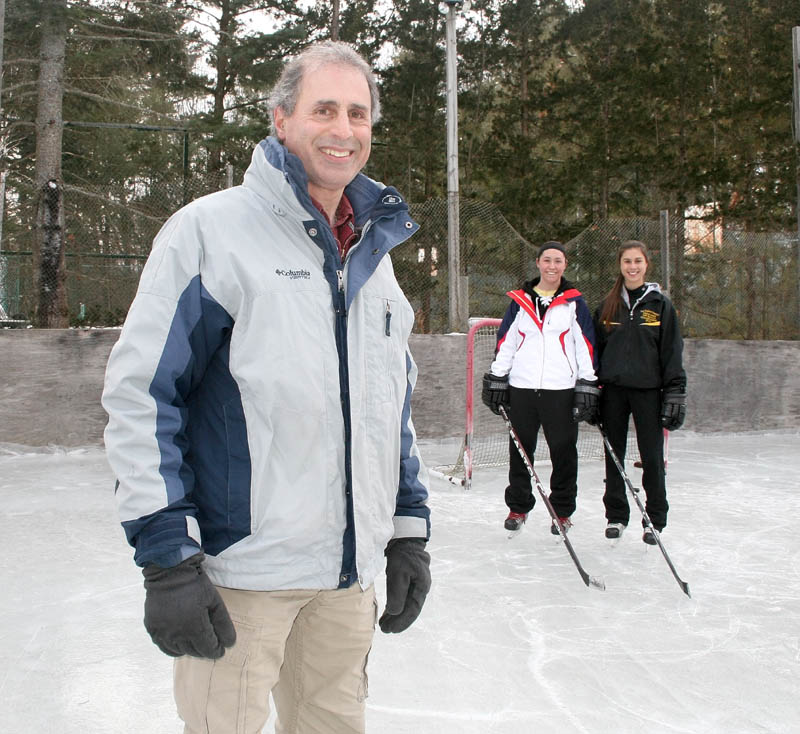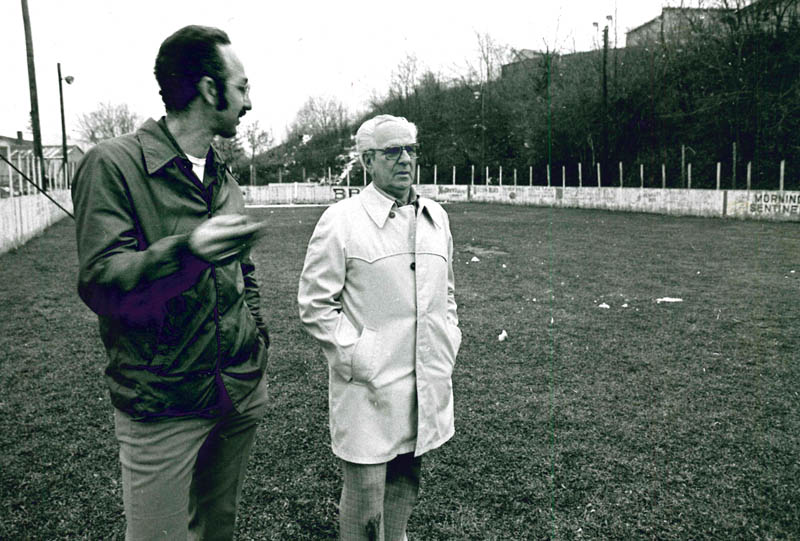WATERVILLE — Time is cyclical, some say.
Decades ago, outdoor ice skating rinks were commonplace in central Maine. In the 1960s and ’70s, scads of school-aged boys roamed from neighborhood to neighborhood, playing pickup hockey games on makeshift backyard rinks and public facilities. Thanks to the wide availability of free ice and free time, an entire generation of skaters earned high school championships, college stardom and — in one case — Olympic status.
In the 1990s, however, the rinks dried up and interest faded in central Maine. Now the organizers behind two recently opened outdoor rinks hope their facilities will recapture old glory.
Well-known hockey town
At the bottom of a steep bank just east of Summer Street lie the ruins of a cherished landmark: South End Arena. Today the 1.7-acre open lot is a tangle of winter-browned weeds, but for 44 years it was a hub for ice skaters in wintertime.
From 1946 to 1990, two generations of the Gagne family maintained the arena. Although the land was private, the arena was public — open to anyone with the means to get there. Arthur Gagne, the family patriarch, ran the arena for the bulk of its existence, until 1983, when he turned it over to his son.
The elder Gagne — a longtime captain for the Waterville Police Department — hosted boxing matches and political rallies at the site, but it was best known for ice skating.
The arena was nearly a full-sized rink, encircled by hockey boards with painted advertisements from local businesses. It was funded in small part by the city of Waterville, but it was Gagne who kept it going, according to Morning Sentinel archives. The arena was such a community asset that Gagne won several awards for his efforts, including the Book of Golden Deeds award and Citizen of the Year from local clubs.
The site also featured a warming hut with pinball machines, pool tables and a jukebox. Gagne reportedly liked children, but he could be stern with them. He had a policy of making them put a quarter into the jukebox each time he caught one swearing.
“Kids are nice,” he said during a Morning Sentinel interview in 1982. “I don’t care what anyone says.”
Gagne died in 1990; the arena faltered that same year.
Twenty-three years later, the organizers behind two outdoor rinks are hoping to evoke the spirit of Gagne’s arena and rekindle a culture of skating.
Earlier this season in Winslow, town Councilor Ray Caron was one of a few volunteers who helped build a small rink on Danielson Street between Winslow’s junior high and high schools. The $1,000 project, which was funded through donations, was inspired largely by the South End Arena.
“I can remember when I was young, living in South End,” said Caron, 57. “We would skate for hours in the cold and have such a great time, and I thought that maybe we could provide that feeling to the youth of today.”
Winslow’s new rink also drew inspiration from the outdoor rink at the Alfond Youth Center on North Street in Waterville, which is in its second season of operation. This year, the center added a warming hut, a skate sharpener and outdoor lighting, which provides night skating until 8 p.m. Fridays and Saturdays.
Ken Walsh, chief operating officer at the center, said the goal is to introduce more people to skating and give hockey players more practice time.
“This was always well-known as a hockey town,” he said. “We’re hoping places like this will help put us back on the map.”
For five consecutive years, from 1969 to 1973, the hockey team at Waterville High School won the state championship. The school also earned three consecutive championships beginning in 1979, according to state records.
Former Waterville mayor Dana Sennett played hockey for the Waterville team during the first championship streak and eventually played for Boston University.
Sennett, an advertising account executive for the Morning Sentinel, said three factors in Waterville contributed to the school’s success at the time: Franco-American culture, a semi-professional team and the widespread availability of free ice.
The Canada connection
The origin of hockey is a matter of some dispute. Some say it was born in the early 1800s on skating ponds in Windsor, Nova Scotia, and spread westward across the provinces. Others say it developed in Kingston, Montreal or Ottawa.
One thing is indisputable, however: Hockey is Canadian.
In the mid-1800s, central Maine was a new home for thousands of French-Canadian immigrants, and they brought hockey with them, said Pearley Lachance — a board member on the Franco-American Heritage Society of Kennebec Valley.
One hundred years later, there was yet another — albeit much smaller — influx when a few Quebecers arrived in Waterville to play for the town’s now-defunct semi-pro hockey team — the Waterville Exchange Club Bruins.
Roger Gagnon moved from St.-Germain, Quebec, in 1958 to play right wing for the Bruins. Gagnon was 18 at the time and a scant 122 pounds; he was one of the smallest players on the ice.
For about five years, the Bruins’ home rink was at Colby College, where they played teams from all over the Northeast and Canada, as well as an exhibition game against the Swiss Olympic team, Gagnon said.
During free time, Gagnon and other Bruins would spend time with Arthur Gagne at South End Arena, teaching children to skate.
“We’d go over there and scrimmage just to have fun,” the 73-year-old Belgrade resident recalled in a heavy French accent.
The players’ presence inspired a generation of children to dream big, Sennett said.
“We thought we could be just like them.”
Out in the streets
In the 1960s and ’70s, hockey couldn’t be contained to organized play.
Across Waterville, about 15 neighborhood teams with names such as the Apaches, the Frogs and The Clan met on backyard ice rinks on Mathews Avenue, Oak Knoll Drive, Ursula Street and many more.
The play was rough and hockey equipment was scarce. Boys sometimes would tape magazines to their shins as their only padding. Helmets were uncommon, facemasks were nonexistent and teeth were often lost.
“Thank God my dad was a dentist, because my two front teeth are not my own,” said Dan Dubord, a board member at the Alfond Youth Center.
Dubord and many others from the era describe an almost Rockwellian image of daily life in Waterville. Teenage boys would run off to school with ice skates and hockey sticks slung over their shoulders. Afterward, they would run to outdoor rinks and play hockey well into the night.
“We wouldn’t leave until our parents came and got us — sometimes not until 10 o’clock,” Dubord recalled. “In the mid-’60s and early ’70s, that’s all we had to do. All we did was play hockey.”
On Burleigh Street, the Winters family maintained a homemade rink in their barn for a winter. Other years, the family built an outdoor rink encircled with boards and long strands of 100-watt light bulbs hanging over the ice. Sometimes the Winterses’ mother would serve hot dogs to the players, up to 25 hot dogs at a time, Dubord recalled.
On Summer Street, the Bolducs — a family of 11 — maintained a small outdoor rink in their yard. One of the children, Danny Bolduc, played during a championship year at Waterville High School, then went on to play for the 1976 U.S Olympic team, the Detroit Red Wings, the Calgary Flames and the New England Whalers.
Bolduc, now 59, credits outdoor skating and neighborhood teams for his 10-year professional career. Small rinks make for better players, he said.
“When you’re playing in confined quarters, you learn quickly,” he said. “If you’ve got 12 kids on a ice surface that’s extremely small, you better be able to maneuver the puck and skate well, or you’re not going to make any headway.”
Just add water
In the 1960s, Mike Nawfel’s father maintained an outdoor rink in his backyard on Oak Knoll Drive. Today, Nawfel is keeping the tradition alive.
In the early 2000s, Nawfel hired excavators to knock down trees and level the land on his Eaton Drive property. There, the former Bowdoin College hockey player built a permanent hockey rink with boards and spotlights so his two daughters could skate.
Daughter Jena Nawfel, now 17, plays for a girls’ hockey team through the Skating Association of Maine at the Ice Vault in Augusta. A decade ago, she thought her father was a little bit nuts when he built the structure. She wasn’t the only one.
“My neighbors definitely thought I was crazy,” Mike Nawfel said.
For a few years, the rink attracted a lot of attention in the neighborhood and youths in full equipment would come over and play. Since then, however, the momentum has died out.
Elsewhere in the city, the momentum died out long ago, he said. Many of the parents who maintained backyard rinks stopped doing it after their children left for college. Relatively few rinks have popped up since.
“It’s just not the same. It’s a different world now. You can’t just let your kids go do things. It has to be structured,” Nawfel, 56, said. “You can’t just walk around the city like we used to. We’d say goodbye to our parents in the morning and say, ‘See you at supper,’ and we wouldn’t see them again until then.”
Nawfel estimates he spent more than $10,000 to erect his rink, but it can be done for much, much less.
In the ’60s, his father would round up neighborhood volunteers to help pack down snow in the yard until it was a firm surface with a ring of snowbanks at the perimeter.
“Then he’d put the hose to it,” Nawfel said.
Walsh said ice rinks are relatively easy to achieve. It’s low-tech. Dozens of instructional videos are available on YouTube.
“All you need is water and labor,” he said.
In the meantime, the outdoor rinks at Winslow and the Alfond Youth Center are open during daylight hours, weather permitting. Bolduc thinks their availability could spur another golden age of hockey in central Maine.
“I’m hoping more and more kids will get out there and skate — and if they do, better days are ahead of us.”
Ben McCanna — 861-9239
bmccanna@centralmaine.com
Send questions/comments to the editors.






Comments are no longer available on this story